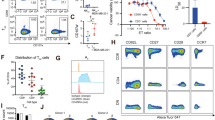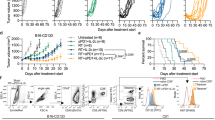Abstract
As many as 80% of patients with breast, prostate, or lung cancer develop bone metastases during the course of their illness. However, thus far, no attempts have been made to explore the potential value of adoptive immunotherapy with antigen-specific T lymphocytes specifically for the treatment of skeletal metastases. Here, we demonstrate tumor regression in a preclinical model of bone metastases from the murine B16BL6 melanoma following adoptive transfer of effector T lymphocytes obtained from tumor vaccine draining lymph nodes. The antitumor effect required transfer of high number of effector cells, which was dependent on CD8+ cells as demonstrated by in vivo depletion of different T cell subsets, and was magnified if effector cells were administered to the arterial supply of the bone/bone marrow. Using flow cytometric analysis, CFSE-labelled Thy1.1+ donor T cells were isolated from the bone marrow of tumor-bearing mice at 24 h and 6 days following adoptive transfer. At the latter time point cell division of the transferred effector cells was detectable. Currently, no curative treatment is known for skeletal metastases in clinical practice. Considering the promising early findings in the present study, further studies exploring the therapeutic potential of adoptive immunotherapy for metastatic disease to the skeleton are warranted.
Similar content being viewed by others
References
Coleman RE. Skeletal complications of malignancy. Cancer 1997; 80: 1588–94.
Tong D, Gillick L, Hendrickson FR. The palliation of symptomatic osseous metastases. Final results of the study by the Radiation Therapy Oncology Group. Cancer 1982; 50: 893–9.
Janjan N. Bone metastases: Approaches to management. Semin Oncol 2001; 28 (4 Suppl 11): 28–34.
Winter H, Hu H-M, Urba WJ et al. Tumor regression after adoptive transfer of effector T cells is independent of perforin or FAS ligand (APO-1L/CD95L). J Immunol 1999; 163: 4462–72.
Lechaux D, Gervais A, Dazord L et al. Adoptive immunotherapy monitored by micro-MRI in experimental colorectal liver metastasis. Anticancer Res 2002; 22: 151–58.
Inoue M, Plautz GE, Shu S. Treatment of intracranial tumors by systemic transfer of superantigenactivated tumor-draining lymph node T cells. Cancer Res 1996; 56: 4702–8.
Dudley ME, Wunderlich JR, Robbins PF et al. Cancer regression and autoimmunity in patients after clonal repopulation with antitumor lymphocytes. Science 2002, 298: 850–4.
Rüttinger D, Li R, Urba WJ et al. Evaluation of a preclinical model of bone metastasis for the study of adoptive immunotherapy. Eur Surg Res 2003; 35: 346–51.
Arguello F, Baggs RB, Frantz CN. A murine model of experimental metastasis to bone and bone marrow. Cancer Res 1988; 48: 6876–81.
De Bruyn PPH. Structural substrates of bone marrow function. Semin Hematol 1981; 18: 179–93.
Orr FW, Sanchez Sweatman OH, Kostenuik P et al. Tumor-bone interactions in skeletal metastasis. Clin Orthop 1995; 312: 19–33.
Doe B, Selby M, Barnett S et al. Induction of cytotoxic T lymphocytes by intramuscular immunization with plasmid DNA is facilitated by bone marrow-derived cells. Proc Natl Acad Sci 1996; 93: 8578–83.
Hornung RL, Longo DL, Bowersox OC et al. Tumor antigen-specific immunization of bone marrow transplantation donors as adoptive therapy against established tumor. J Natl Cancer Inst 1995; 87: 1289–96.
Müller M, Gounari F, Prifti S et al. EblacZ tumor dormancy in bone marrow and lymph nodes: Active control of proliferating tumor cells by CD8 +immune T cells. Cancer Res 1998; 58: 5439–46.
Pantel K, Izbicki J, Passlick B et al. Frequency and prognostic significance of isolated tumour cells in bone marrow of patients with non-small-cell lung cancer without overt metastases. Lancet 1996; 347: 649–53.
Schlimok G, Funke I, Bock B et al. Epithelial tumor cells in bone marrow of patients with colorectal cancer: Immunocytochemical detection, phenotypic characterization, and prognostic significance. J Clin Oncol 1990; 8: 831–7.
Jauch KW, Heiss MM, Gruetzner U et al. Prognostic significance of bone marrow micrometastases in patients with gastric cancer. J Clin Oncol 1996; 14: 1810–7.
Dillman RO, Hurwitz SR, Schiltz PM et al. Tumor localization by tumor infiltrating lymphocytes labeled with indium-111 in patients with. metastatic renal cell carcinoma, melanoma, and colorectal cancer. Cancer Biother Radiopharm 1997; 12: 65–71.
Griffith KD, Read EJ, Carrasquillo JA et al. In vivo distribution of adoptively transferred indium-111-labeled tumor infiltrating lymph-ocytes and peripheral blood lymphocytes in patients with metastatic melanoma. J. Natl Cancer Inst 1989; 81: 1709–17.
Arca MJ, Krauss JC, Aruga A et al. Therapeutic efficacy of T cells derived from lymph nodes draining a poorly immunogenic tumor transduced to secrete granulocyte-macrophage colony-stimulating factor. Cancer Gene Ther 1996; 3 (1): 39–47.
Hu HM, Winter H, Urba WJ et al. Divergent roles for CD4 4 T cells in the priming and effector/memory phases of adoptive immunotherapy. J Immunol 2000; 165: 4246–53.
Lyons AB. Analysing cell division in vivo and in vitro using flow cyto-metric measurement of CFSE dye dilution. J Immunol Meth 2000; 243: 147–54.
Braun S, Kentenich C, Janni W et al. Lack of effect of adjuvant chemotherapy on the elimination of single dormant tumor cells in bone marrow of high-risk breast cancer patients. J Clin Oncol 2000; 18: 80–6.
Braun S, Pantel K, Muller P et al. Cytokeratin-positive cells in the bone marrow and survival of patients with stage I, II, or III breast cancer. N Engl J Med 2000; 342: 525–33.
Hancock MC, Langton BC, Chan T et al. A monoclonal anti-body against the cerbB-2 protein enhances the cytotoxicity of cisdiamminedichloroplatinum against human breast and ovarian tumor cell lines. Cancer Res 1991; 51: 4575–80.
Pantel K, Schlimok G, Braun S et al. Differential expression of proliferationassociated molecules in individual micrometastatic carcinoma cells. J Natl Cancer Inst 1993; 85: 1419–24.
Trambas CM, Griffiths GM. Delivering the kiss of death. Nat. Immunol 2003; 4: 399–403.
Russell JH, Ley TJ. Lymphocyte-mediated cytotoxicity. Annu Rev Immunol 2002; 20: 323–70.
Kjaergaard J, Hokland ME, Agger R et al. Biodistribution and tumor localization of lymphokine-activated killer T cells following different routes of administration into tumor-bearing animals. Cancer Immunol Immunother 2000; 48: 550–60.
Kjaergaard J, Peng L, Cohen PA et al. Therapeutic efficacy of adoptive immunotherapy is predicated on in vivo antigen-specific proliferation of donor T cells. Clin Immunol 2003; 108: 8–20.
Palframan RT, Jung S, Cheng G et al. Inflammatory chemokine transport and presentation in HEV: A remote control mechanism for monocyte recruitment to lymph nodes in inflamed tissues. J Exp Med 2001; 194: 1361–71.
Shrikant P, Mescher MF. Control of syngeneic tumor growth by activation of CD8+T cells: Efficacy is limited by migration away from the site and induction of nonresponsiveness. J Immunol 1999; 162: 2858–66.
Zhu H, Melder RJ, Baxter LT et al. Physiologically based kinetic model of effector cell biodistribution in mammals: Implications for adoptive immunotherapy. Cancer Res 1996; 56: 3771–81.
Weninger W, Manjunath N, von Andrian UH. Migration and differentiation of CD8 +T cells. Immunol Rev 2002; 186: 221–33.
Muller A, Homey B, Soto H et al. Involvement of chemokine receptors in breast cancer metastasis. Nature 2001; 410: 50–6.
Mora JR, Bono MR, Manjunath N et al. Selective imprinting of gut-homing T cells by Peyer's patch dendritic cells. Nature 2003; 424: 88–93.
Kagamu H, Shu S. Purification of L-selection(low) cells promotes the generation of highly potent CD4 antitumor effector T lymphocytes. J Immunol 1998; 160: 3444–52.
Aruga A, Aruga E, Cameron MJ et al. Different cytokine profiles released by CD4 +and CD8 +tumor-draining lymph node cells involved in mediating tumor regression. J Leuk Biol 1997; 61: 507–16.
Author information
Authors and Affiliations
Corresponding author
Rights and permissions
About this article
Cite this article
Rüttinger, D., Li, R., Urba, W.J. et al. Regression of bone metastases following adoptive transfer of anti-CD3-activated and IL-2-expanded tumor vaccine draining lymph node cells. Clin Exp Metastasis 21, 305–312 (2004). https://doi.org/10.1023/B:CLIN.0000046139.59515.4e
Issue Date:
DOI: https://doi.org/10.1023/B:CLIN.0000046139.59515.4e




